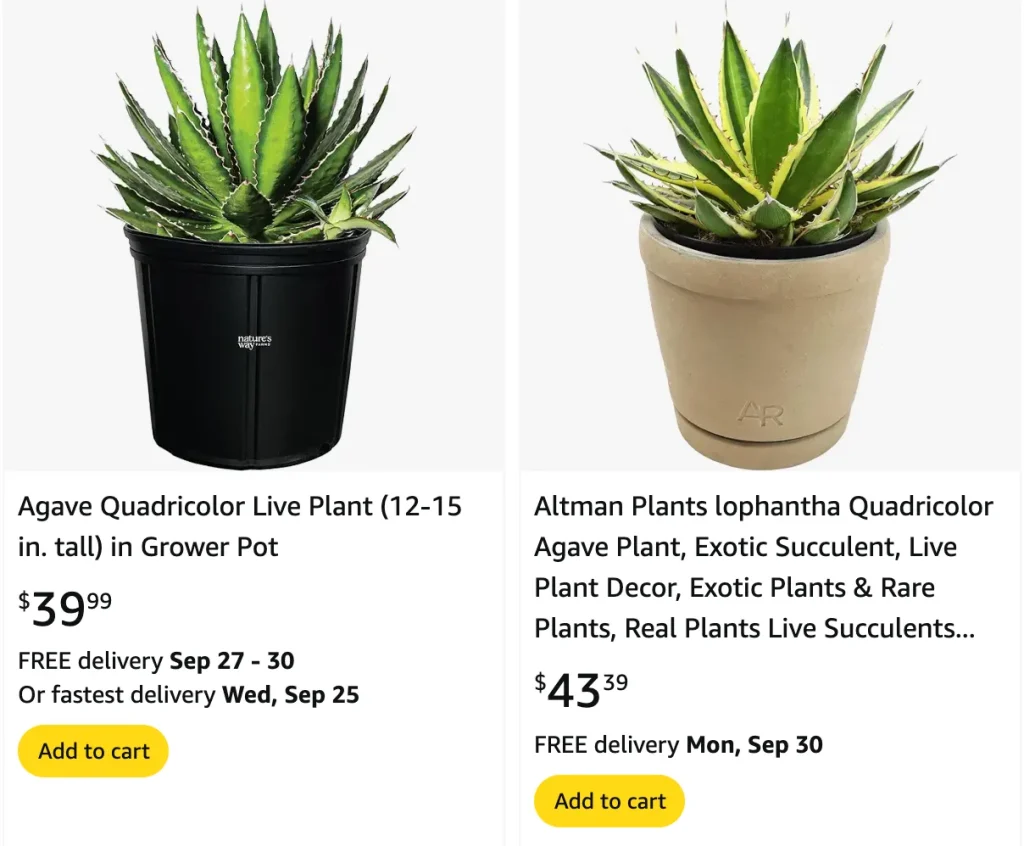
FAQs About Agave Quadricolor
As an avid plant enthusiast, I’ve often found myself captivated by the striking beauty of Agave Quadricolor. If you’re new to this plant or considering adding it to your collection, you might have some questions. I’m here to share what I’ve learned about Agave Quadricolor, covering everything from its nature as a succulent to care tips and common issues.
304 Species in Genus Agave
What Is Agave Quadricolor?
Agave Quadricolor is a fascinating plant, renowned for its unique, variegated leaves. It’s a type of agave that stands out due to its colorful foliage, which typically features shades of green, yellow, and sometimes even hints of red. This plant, native to Mexico, is often appreciated for its ornamental value and relatively low maintenance needs.
Is Agave Quadricolor a Succulent?
Yes, Agave Quadricolor is indeed a succulent. Like other succulents, it stores water in its leaves, which allows it to survive in arid conditions. Its thick, fleshy leaves are a hallmark of succulent plants, making it a great choice for those who prefer low-water, drought-tolerant options.
How to Care for Agave Quadricolor?
Caring for Agave Quadricolor is fairly straightforward if you follow a few key guidelines:
- Light: This plant thrives in bright, indirect light. It can handle some direct sunlight, but too much can cause leaf burn.
- Watering: Agave Quadricolor prefers to dry out between waterings. Water it thoroughly but infrequently. Overwatering can lead to root rot, a common issue with succulents.
- Soil: Use well-draining soil, like a cactus or succulent mix. This helps prevent water from accumulating at the roots.
- Temperature: It prefers temperatures between 60°F and 80°F (15°C to 27°C). While it can tolerate brief periods of cold, it’s best to protect it from frost.
- Fertilizing: Feed your Agave Quadricolor with a balanced, diluted fertilizer during the growing season (spring and summer). Reduce feeding in fall and winter when the plant is dormant.
How to Propagate Agave Quadricolor?
Propagating Agave Quadricolor can be done through offsets or pups, which are small plantlets that grow around the base of the main plant. Here’s how you can propagate:
- Wait for Offsets: Allow the plant to produce offsets. These are small clones of the parent plant that grow at the base.
- Separate Offsets: Once the offsets are a reasonable size and have their own roots, gently separate them from the main plant.
- Plant Separately: Plant the offsets in a well-draining potting mix and water lightly.
- Care for New Plants: Keep the new plants in bright, indirect light and follow the same care routine as you would for the mature plant.
What to Plant With Agave Quadricolor?
Agave Quadricolor pairs well with other succulents and desert plants. Some good companions include:
- Sedum: Varieties like Sedum ‘Autumn Joy’ complement the agave’s look.
- Echeveria: Their rosette shapes and colors harmonize well with the agave’s foliage.
- Cacti: Small cacti can add a contrasting texture and are well-suited to the same dry conditions.
Can You Grow Agave Quadricolor Indoors?
Yes, Agave Quadricolor can be grown indoors, but it requires a bright spot. A south-facing window is ideal. Ensure it receives plenty of light to mimic its natural environment. Indoor humidity levels should be low, as this plant prefers dry conditions.
Is Agave Quadricolor Toxic?
Agave Quadricolor is not known to be toxic to humans or pets. However, as with many succulents, it’s best to avoid ingestion, as some people may experience minor irritation if they come into contact with the plant’s sap.
Benefits of Growing Agave Quadricolor
- Low Maintenance: It’s an excellent choice for those who prefer low-care plants.
- Ornamental Value: Its striking colors and architectural form make it a standout feature in any garden or indoor space.
- Drought-Tolerant: It’s ideal for water-wise gardening, making it suitable for xeriscapes.
Common Problems with Agave Quadricolor
- Overwatering: This can lead to root rot. Ensure the soil dries out between waterings.
- Pest Issues: Look out for mealybugs and scale insects. Treat infestations promptly with insecticidal soap or neem oil.
- Leaf Burn: Excessive direct sunlight can cause leaf burn. Provide some shade if necessary.
Compare with Similar Plants
When comparing Agave Quadricolor with other agave species, such as Agave Victoriae-Reginae or Agave Attenuata, you’ll notice differences in leaf shape and color patterns. Agave Victoriae-Reginae has a more compact rosette with white markings, while Agave Attenuata features smoother, less variegated leaves. Each has its own charm and care requirements, but Agave Quadricolor’s vibrant color scheme and relatively easy care make it a standout choice for many.
In conclusion, Agave Quadricolor is a beautiful, resilient plant that adds a splash of color and interest to any collection. By understanding its care needs and potential issues, you can enjoy its striking presence for years to come.
If i die, water my plants!



